RMIT MIET7547C - Fluid & Thermodynamics Principles Assignment
VerifiedAdded on 2023/06/11
|22
|4839
|87
Homework Assignment
AI Summary
This assignment focuses on applying fluid and thermodynamics principles in an engineering context. It covers topics such as fluid dynamics, including continuity of flow and Bernoulli's equation, and fluid power. The assignment includes problems involving calculations of flow velocity, Reynolds number, mass flow rate, volumetric flow rate, pressure, and fluid power. Specific scenarios involve oil flow through a pipe, liquid pumped through a transition piece, and air flowing through an inclined duct with a reducer. The problems require the application of fundamental equations and principles to determine various parameters related to fluid flow and energy transfer. The last question deals with fluid power transferred by a pump to water flowing in a horizontal pipe, increase in fluid head, efficiency and cost of running a pump.
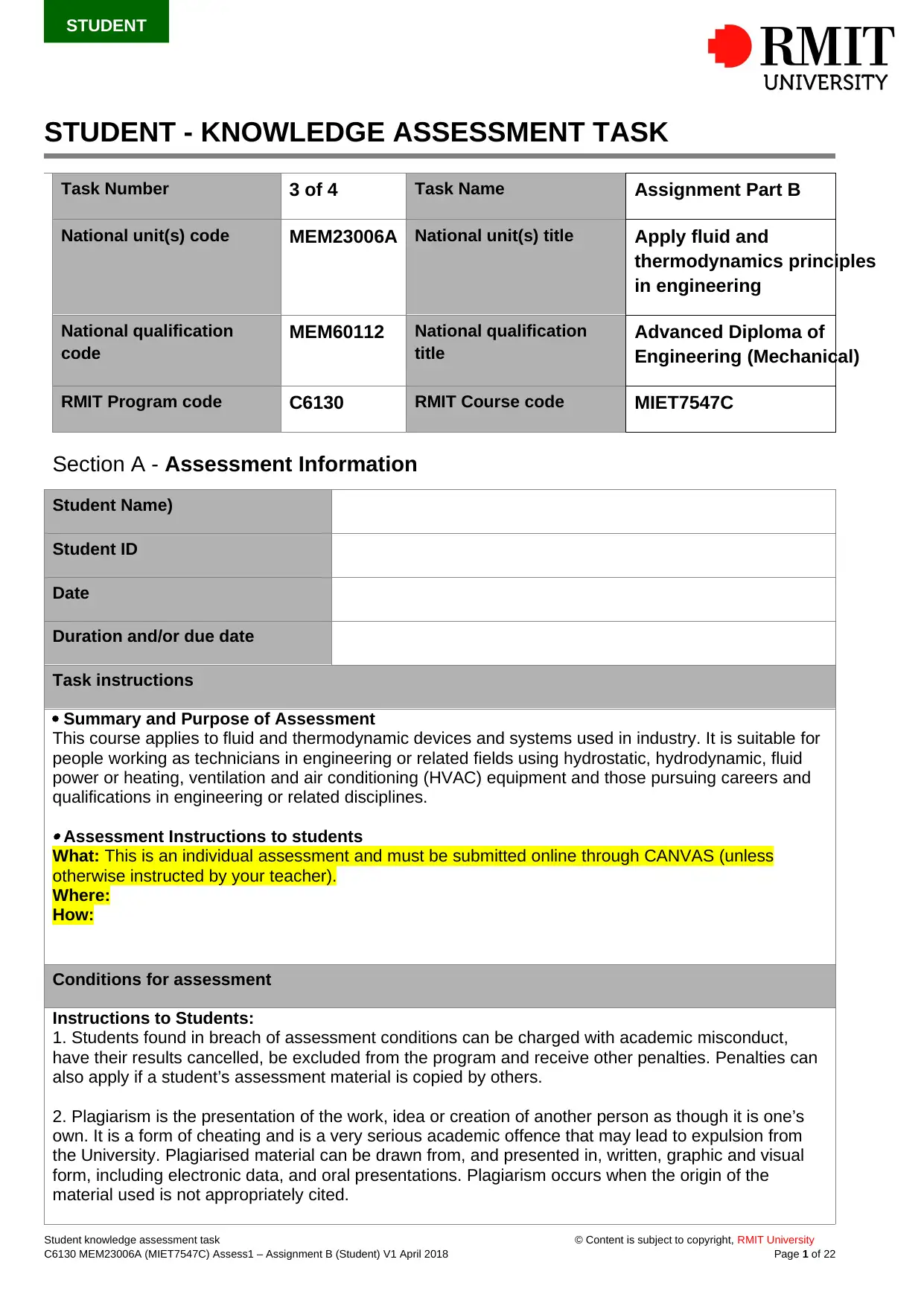
STUDENT
STUDENT - KNOWLEDGE ASSESSMENT TASK
Task Number 3 of 4 Task Name Assignment Part B
National unit(s) code MEM23006A National unit(s) title Apply fluid and
thermodynamics principles
in engineering
National qualification
code
MEM60112 National qualification
title
Advanced Diploma of
Engineering (Mechanical)
RMIT Program code C6130 RMIT Course code MIET7547C
Section A - Assessment Information
Student Name)
Student ID
Date
Duration and/or due date
Task instructions
Summary and Purpose of Assessment
This course applies to fluid and thermodynamic devices and systems used in industry. It is suitable for
people working as technicians in engineering or related fields using hydrostatic, hydrodynamic, fluid
power or heating, ventilation and air conditioning (HVAC) equipment and those pursuing careers and
qualifications in engineering or related disciplines.
Assessment Instructions to students
What: This is an individual assessment and must be submitted online through CANVAS (unless
otherwise instructed by your teacher).
Where:
How:
Conditions for assessment
Instructions to Students:
1. Students found in breach of assessment conditions can be charged with academic misconduct,
have their results cancelled, be excluded from the program and receive other penalties. Penalties can
also apply if a student’s assessment material is copied by others.
2. Plagiarism is the presentation of the work, idea or creation of another person as though it is one’s
own. It is a form of cheating and is a very serious academic offence that may lead to expulsion from
the University. Plagiarised material can be drawn from, and presented in, written, graphic and visual
form, including electronic data, and oral presentations. Plagiarism occurs when the origin of the
material used is not appropriately cited.
Student knowledge assessment task © Content is subject to copyright, RMIT University
C6130 MEM23006A (MIET7547C) Assess1 – Assignment B (Student) V1 April 2018 Page 1 of 22
STUDENT - KNOWLEDGE ASSESSMENT TASK
Task Number 3 of 4 Task Name Assignment Part B
National unit(s) code MEM23006A National unit(s) title Apply fluid and
thermodynamics principles
in engineering
National qualification
code
MEM60112 National qualification
title
Advanced Diploma of
Engineering (Mechanical)
RMIT Program code C6130 RMIT Course code MIET7547C
Section A - Assessment Information
Student Name)
Student ID
Date
Duration and/or due date
Task instructions
Summary and Purpose of Assessment
This course applies to fluid and thermodynamic devices and systems used in industry. It is suitable for
people working as technicians in engineering or related fields using hydrostatic, hydrodynamic, fluid
power or heating, ventilation and air conditioning (HVAC) equipment and those pursuing careers and
qualifications in engineering or related disciplines.
Assessment Instructions to students
What: This is an individual assessment and must be submitted online through CANVAS (unless
otherwise instructed by your teacher).
Where:
How:
Conditions for assessment
Instructions to Students:
1. Students found in breach of assessment conditions can be charged with academic misconduct,
have their results cancelled, be excluded from the program and receive other penalties. Penalties can
also apply if a student’s assessment material is copied by others.
2. Plagiarism is the presentation of the work, idea or creation of another person as though it is one’s
own. It is a form of cheating and is a very serious academic offence that may lead to expulsion from
the University. Plagiarised material can be drawn from, and presented in, written, graphic and visual
form, including electronic data, and oral presentations. Plagiarism occurs when the origin of the
material used is not appropriately cited.
Student knowledge assessment task © Content is subject to copyright, RMIT University
C6130 MEM23006A (MIET7547C) Assess1 – Assignment B (Student) V1 April 2018 Page 1 of 22
Paraphrase This Document
Need a fresh take? Get an instant paraphrase of this document with our AI Paraphraser
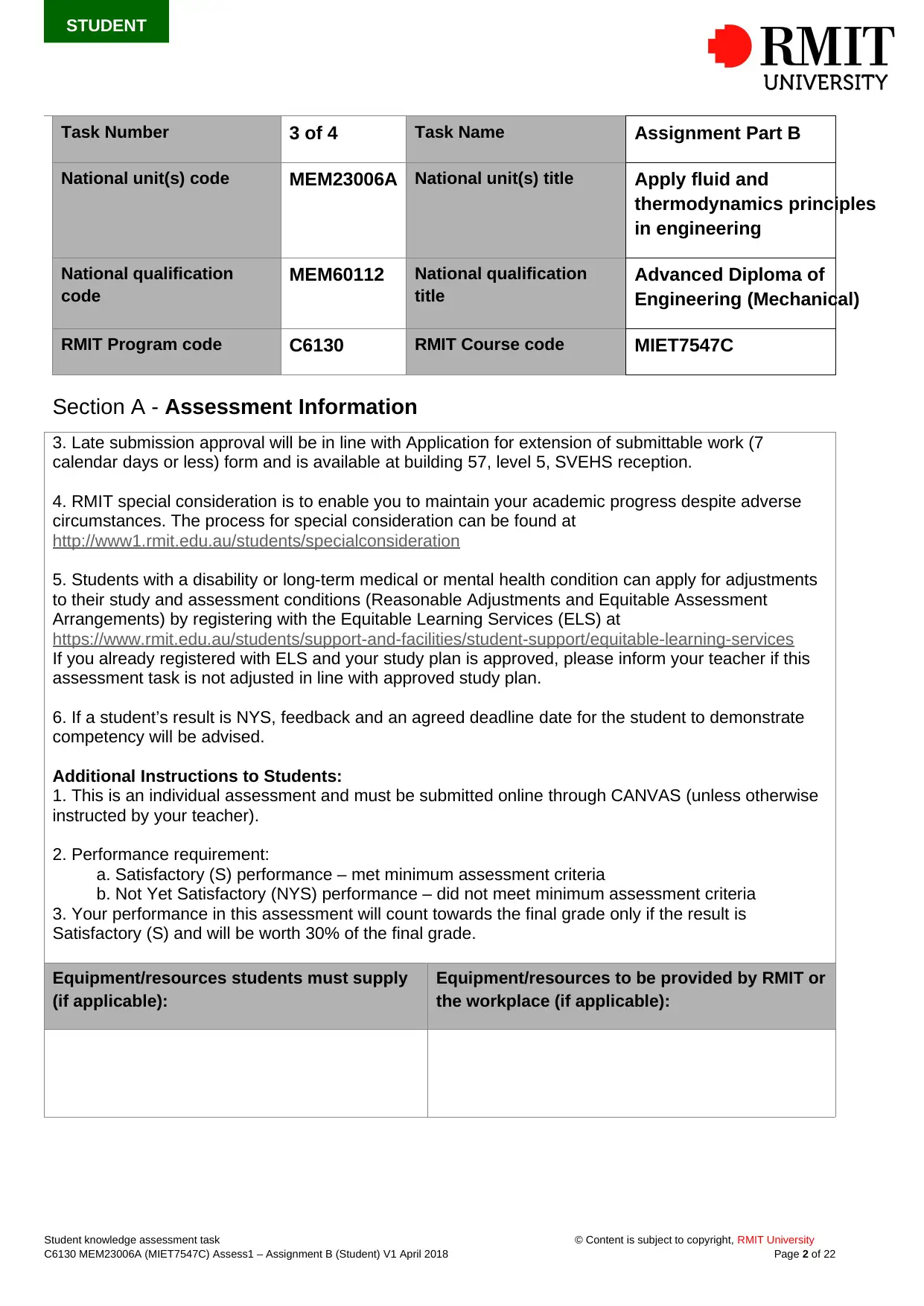
STUDENT
Task Number 3 of 4 Task Name Assignment Part B
National unit(s) code MEM23006A National unit(s) title Apply fluid and
thermodynamics principles
in engineering
National qualification
code
MEM60112 National qualification
title
Advanced Diploma of
Engineering (Mechanical)
RMIT Program code C6130 RMIT Course code MIET7547C
Section A - Assessment Information
3. Late submission approval will be in line with Application for extension of submittable work (7
calendar days or less) form and is available at building 57, level 5, SVEHS reception.
4. RMIT special consideration is to enable you to maintain your academic progress despite adverse
circumstances. The process for special consideration can be found at
http://www1.rmit.edu.au/students/specialconsideration
5. Students with a disability or long-term medical or mental health condition can apply for adjustments
to their study and assessment conditions (Reasonable Adjustments and Equitable Assessment
Arrangements) by registering with the Equitable Learning Services (ELS) at
https://www.rmit.edu.au/students/support-and-facilities/student-support/equitable-learning-services
If you already registered with ELS and your study plan is approved, please inform your teacher if this
assessment task is not adjusted in line with approved study plan.
6. If a student’s result is NYS, feedback and an agreed deadline date for the student to demonstrate
competency will be advised.
Additional Instructions to Students:
1. This is an individual assessment and must be submitted online through CANVAS (unless otherwise
instructed by your teacher).
2. Performance requirement:
a. Satisfactory (S) performance – met minimum assessment criteria
b. Not Yet Satisfactory (NYS) performance – did not meet minimum assessment criteria
3. Your performance in this assessment will count towards the final grade only if the result is
Satisfactory (S) and will be worth 30% of the final grade.
Equipment/resources students must supply
(if applicable):
Equipment/resources to be provided by RMIT or
the workplace (if applicable):
Student knowledge assessment task © Content is subject to copyright, RMIT University
C6130 MEM23006A (MIET7547C) Assess1 – Assignment B (Student) V1 April 2018 Page 2 of 22
Task Number 3 of 4 Task Name Assignment Part B
National unit(s) code MEM23006A National unit(s) title Apply fluid and
thermodynamics principles
in engineering
National qualification
code
MEM60112 National qualification
title
Advanced Diploma of
Engineering (Mechanical)
RMIT Program code C6130 RMIT Course code MIET7547C
Section A - Assessment Information
3. Late submission approval will be in line with Application for extension of submittable work (7
calendar days or less) form and is available at building 57, level 5, SVEHS reception.
4. RMIT special consideration is to enable you to maintain your academic progress despite adverse
circumstances. The process for special consideration can be found at
http://www1.rmit.edu.au/students/specialconsideration
5. Students with a disability or long-term medical or mental health condition can apply for adjustments
to their study and assessment conditions (Reasonable Adjustments and Equitable Assessment
Arrangements) by registering with the Equitable Learning Services (ELS) at
https://www.rmit.edu.au/students/support-and-facilities/student-support/equitable-learning-services
If you already registered with ELS and your study plan is approved, please inform your teacher if this
assessment task is not adjusted in line with approved study plan.
6. If a student’s result is NYS, feedback and an agreed deadline date for the student to demonstrate
competency will be advised.
Additional Instructions to Students:
1. This is an individual assessment and must be submitted online through CANVAS (unless otherwise
instructed by your teacher).
2. Performance requirement:
a. Satisfactory (S) performance – met minimum assessment criteria
b. Not Yet Satisfactory (NYS) performance – did not meet minimum assessment criteria
3. Your performance in this assessment will count towards the final grade only if the result is
Satisfactory (S) and will be worth 30% of the final grade.
Equipment/resources students must supply
(if applicable):
Equipment/resources to be provided by RMIT or
the workplace (if applicable):
Student knowledge assessment task © Content is subject to copyright, RMIT University
C6130 MEM23006A (MIET7547C) Assess1 – Assignment B (Student) V1 April 2018 Page 2 of 22
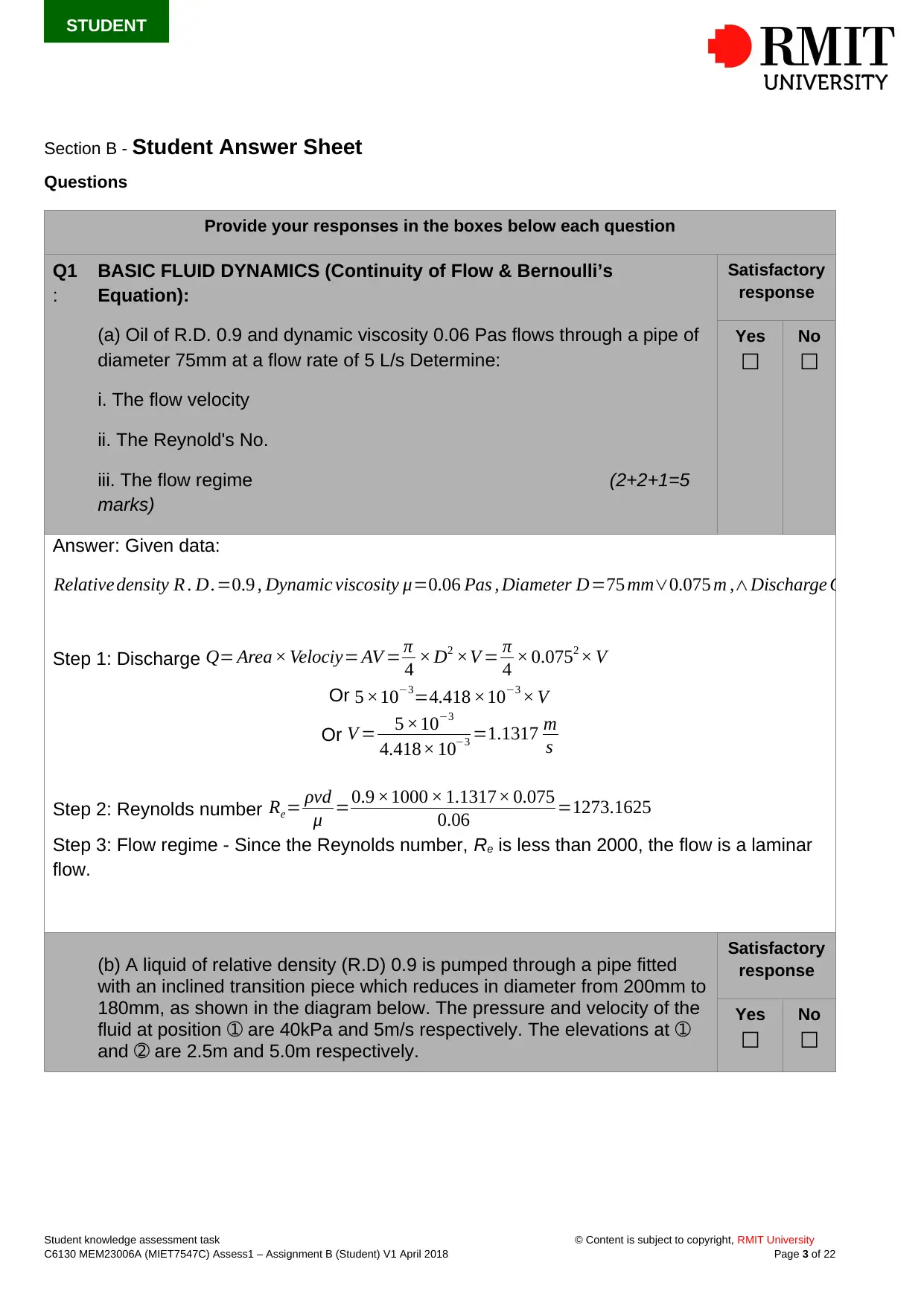
STUDENT
Section B - Student Answer Sheet
Questions
Provide your responses in the boxes below each question
Q1
:
BASIC FLUID DYNAMICS (Continuity of Flow & Bernoulli’s
Equation):
(a) Oil of R.D. 0.9 and dynamic viscosity 0.06 Pas flows through a pipe of
diameter 75mm at a flow rate of 5 L/s Determine:
i. The flow velocity
ii. The Reynold's No.
iii. The flow regime (2+2+1=5
marks)
Satisfactory
response
Yes
☐
No
☐
Answer: Given data:
Relative density R . D.=0.9 , Dynamic viscosity μ=0.06 Pas , Diameter D=75 mm∨0.075 m ,∧Discharge Q=5 liter
s =5
Step 1: Discharge Q= Area × Velociy= AV = π
4 × D2 ×V = π
4 × 0.0752 × V
Or 5 ×10−3=4.418 ×10−3 × V
Or V = 5 ×10−3
4.418× 10−3 =1.1317 m
s
Step 2: Reynolds number Re= ρvd
μ =0.9 ×1000 × 1.1317× 0.075
0.06 =1273.1625
Step 3: Flow regime - Since the Reynolds number, Re is less than 2000, the flow is a laminar
flow.
(b) A liquid of relative density (R.D) 0.9 is pumped through a pipe fitted
with an inclined transition piece which reduces in diameter from 200mm to
180mm, as shown in the diagram below. The pressure and velocity of the
fluid at position ➀ are 40kPa and 5m/s respectively. The elevations at ➀
and ➁ are 2.5m and 5.0m respectively.
Satisfactory
response
Yes
☐
No
☐
Student knowledge assessment task © Content is subject to copyright, RMIT University
C6130 MEM23006A (MIET7547C) Assess1 – Assignment B (Student) V1 April 2018 Page 3 of 22
Section B - Student Answer Sheet
Questions
Provide your responses in the boxes below each question
Q1
:
BASIC FLUID DYNAMICS (Continuity of Flow & Bernoulli’s
Equation):
(a) Oil of R.D. 0.9 and dynamic viscosity 0.06 Pas flows through a pipe of
diameter 75mm at a flow rate of 5 L/s Determine:
i. The flow velocity
ii. The Reynold's No.
iii. The flow regime (2+2+1=5
marks)
Satisfactory
response
Yes
☐
No
☐
Answer: Given data:
Relative density R . D.=0.9 , Dynamic viscosity μ=0.06 Pas , Diameter D=75 mm∨0.075 m ,∧Discharge Q=5 liter
s =5
Step 1: Discharge Q= Area × Velociy= AV = π
4 × D2 ×V = π
4 × 0.0752 × V
Or 5 ×10−3=4.418 ×10−3 × V
Or V = 5 ×10−3
4.418× 10−3 =1.1317 m
s
Step 2: Reynolds number Re= ρvd
μ =0.9 ×1000 × 1.1317× 0.075
0.06 =1273.1625
Step 3: Flow regime - Since the Reynolds number, Re is less than 2000, the flow is a laminar
flow.
(b) A liquid of relative density (R.D) 0.9 is pumped through a pipe fitted
with an inclined transition piece which reduces in diameter from 200mm to
180mm, as shown in the diagram below. The pressure and velocity of the
fluid at position ➀ are 40kPa and 5m/s respectively. The elevations at ➀
and ➁ are 2.5m and 5.0m respectively.
Satisfactory
response
Yes
☐
No
☐
Student knowledge assessment task © Content is subject to copyright, RMIT University
C6130 MEM23006A (MIET7547C) Assess1 – Assignment B (Student) V1 April 2018 Page 3 of 22
⊘ This is a preview!⊘
Do you want full access?
Subscribe today to unlock all pages.

Trusted by 1+ million students worldwide
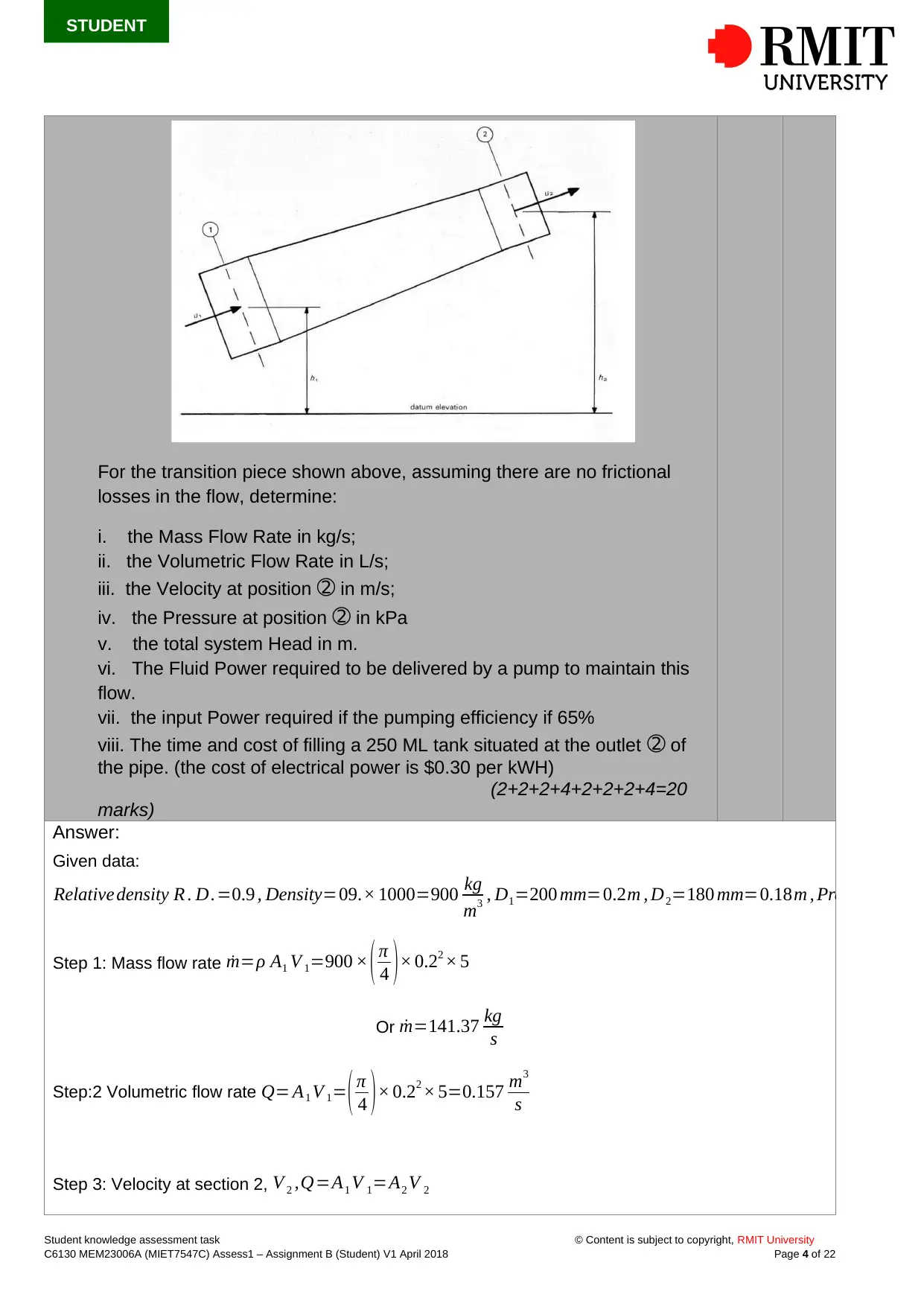
STUDENT
For the transition piece shown above, assuming there are no frictional
losses in the flow, determine:
i. the Mass Flow Rate in kg/s;
ii. the Volumetric Flow Rate in L/s;
iii. the Velocity at position ➁ in m/s;
iv. the Pressure at position ➁ in kPa
v. the total system Head in m.
vi. The Fluid Power required to be delivered by a pump to maintain this
flow.
vii. the input Power required if the pumping efficiency if 65%
viii. The time and cost of filling a 250 ML tank situated at the outlet ➁ of
the pipe. (the cost of electrical power is $0.30 per kWH)
(2+2+2+4+2+2+2+4=20
marks)
Answer:
Given data:
Relative density R . D.=0.9 , Density=09.× 1000=900 kg
m3 , D1=200 mm=0.2m , D2=180 mm=0.18m , Pressure p1=4
Step 1: Mass flow rate ˙m=ρ A1 V 1=900 × ( π
4 )× 0.22 × 5
Or ˙m=141.37 kg
s
Step:2 Volumetric flow rate Q= A1 V 1= ( π
4 ) × 0.22 × 5=0.157 m3
s
Step 3: Velocity at section 2, V 2 ,Q=A1 V 1=A2 V 2
Student knowledge assessment task © Content is subject to copyright, RMIT University
C6130 MEM23006A (MIET7547C) Assess1 – Assignment B (Student) V1 April 2018 Page 4 of 22
For the transition piece shown above, assuming there are no frictional
losses in the flow, determine:
i. the Mass Flow Rate in kg/s;
ii. the Volumetric Flow Rate in L/s;
iii. the Velocity at position ➁ in m/s;
iv. the Pressure at position ➁ in kPa
v. the total system Head in m.
vi. The Fluid Power required to be delivered by a pump to maintain this
flow.
vii. the input Power required if the pumping efficiency if 65%
viii. The time and cost of filling a 250 ML tank situated at the outlet ➁ of
the pipe. (the cost of electrical power is $0.30 per kWH)
(2+2+2+4+2+2+2+4=20
marks)
Answer:
Given data:
Relative density R . D.=0.9 , Density=09.× 1000=900 kg
m3 , D1=200 mm=0.2m , D2=180 mm=0.18m , Pressure p1=4
Step 1: Mass flow rate ˙m=ρ A1 V 1=900 × ( π
4 )× 0.22 × 5
Or ˙m=141.37 kg
s
Step:2 Volumetric flow rate Q= A1 V 1= ( π
4 ) × 0.22 × 5=0.157 m3
s
Step 3: Velocity at section 2, V 2 ,Q=A1 V 1=A2 V 2
Student knowledge assessment task © Content is subject to copyright, RMIT University
C6130 MEM23006A (MIET7547C) Assess1 – Assignment B (Student) V1 April 2018 Page 4 of 22
Paraphrase This Document
Need a fresh take? Get an instant paraphrase of this document with our AI Paraphraser
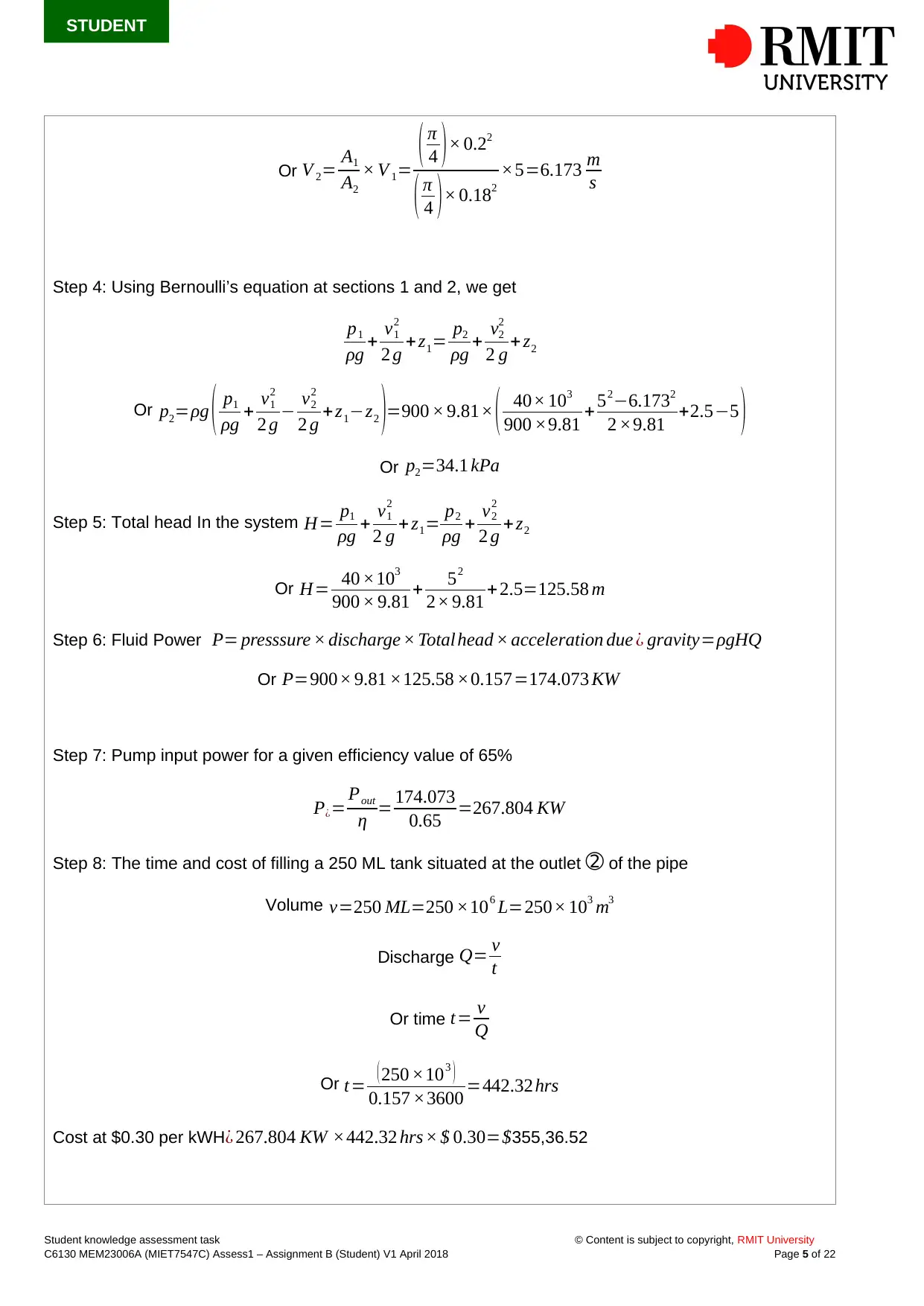
STUDENT
Or V 2= A1
A2
× V 1= ( π
4 )× 0.22
( π
4 )× 0.182
×5=6.173 m
s
Step 4: Using Bernoulli’s equation at sections 1 and 2, we get
p1
ρg + v1
2
2 g + z1= p2
ρg + v2
2
2 g + z2
Or p2=ρg ( p1
ρg + v1
2
2 g − v2
2
2 g + z1−z2 )=900 × 9.81× ( 40× 103
900 ×9.81 + 52−6.1732
2 ×9.81 +2.5−5 )
Or p2=34.1 kPa
Step 5: Total head In the system H= p1
ρg + v1
2
2 g + z1= p2
ρg + v2
2
2 g + z2
Or H= 40 ×103
900 × 9.81 + 52
2× 9.81 +2.5=125.58 m
Step 6: Fluid Power P= presssure × discharge × Totalhead × acceleration due ¿ gravity=ρgHQ
Or P=900× 9.81 ×125.58 ×0.157=174.073 KW
Step 7: Pump input power for a given efficiency value of 65%
P¿= Pout
η = 174.073
0.65 =267.804 KW
Step 8: The time and cost of filling a 250 ML tank situated at the outlet ➁ of the pipe
Volume v=250 ML=250 ×106 L=250× 103 m3
Discharge Q= v
t
Or time t= v
Q
Or t= ( 250 ×103 )
0.157 ×3600 =442.32hrs
Cost at $0.30 per kWH¿ 267.804 KW ×442.32 hrs × $ 0.30=$355,36.52
Student knowledge assessment task © Content is subject to copyright, RMIT University
C6130 MEM23006A (MIET7547C) Assess1 – Assignment B (Student) V1 April 2018 Page 5 of 22
Or V 2= A1
A2
× V 1= ( π
4 )× 0.22
( π
4 )× 0.182
×5=6.173 m
s
Step 4: Using Bernoulli’s equation at sections 1 and 2, we get
p1
ρg + v1
2
2 g + z1= p2
ρg + v2
2
2 g + z2
Or p2=ρg ( p1
ρg + v1
2
2 g − v2
2
2 g + z1−z2 )=900 × 9.81× ( 40× 103
900 ×9.81 + 52−6.1732
2 ×9.81 +2.5−5 )
Or p2=34.1 kPa
Step 5: Total head In the system H= p1
ρg + v1
2
2 g + z1= p2
ρg + v2
2
2 g + z2
Or H= 40 ×103
900 × 9.81 + 52
2× 9.81 +2.5=125.58 m
Step 6: Fluid Power P= presssure × discharge × Totalhead × acceleration due ¿ gravity=ρgHQ
Or P=900× 9.81 ×125.58 ×0.157=174.073 KW
Step 7: Pump input power for a given efficiency value of 65%
P¿= Pout
η = 174.073
0.65 =267.804 KW
Step 8: The time and cost of filling a 250 ML tank situated at the outlet ➁ of the pipe
Volume v=250 ML=250 ×106 L=250× 103 m3
Discharge Q= v
t
Or time t= v
Q
Or t= ( 250 ×103 )
0.157 ×3600 =442.32hrs
Cost at $0.30 per kWH¿ 267.804 KW ×442.32 hrs × $ 0.30=$355,36.52
Student knowledge assessment task © Content is subject to copyright, RMIT University
C6130 MEM23006A (MIET7547C) Assess1 – Assignment B (Student) V1 April 2018 Page 5 of 22
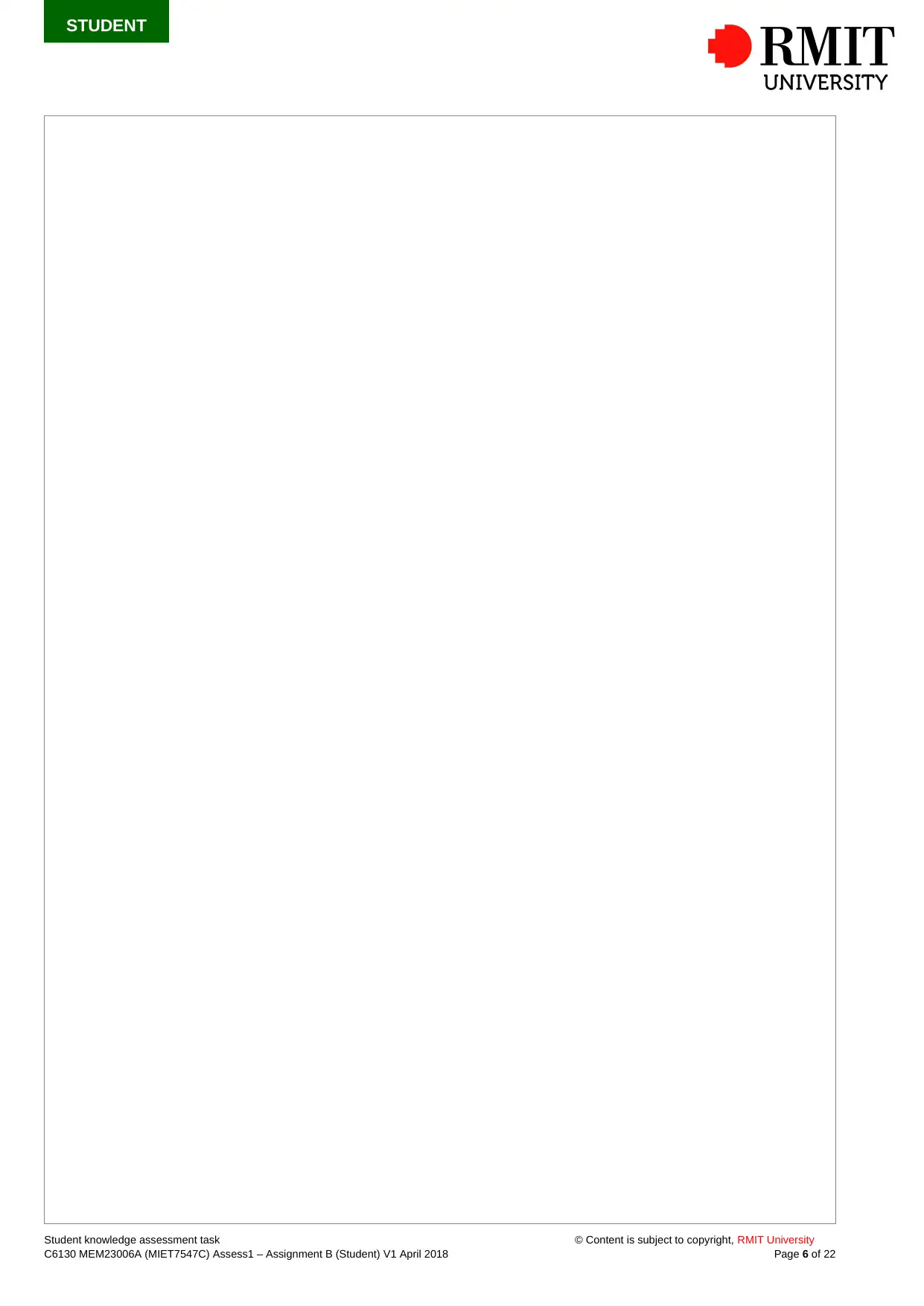
STUDENT
Student knowledge assessment task © Content is subject to copyright, RMIT University
C6130 MEM23006A (MIET7547C) Assess1 – Assignment B (Student) V1 April 2018 Page 6 of 22
Student knowledge assessment task © Content is subject to copyright, RMIT University
C6130 MEM23006A (MIET7547C) Assess1 – Assignment B (Student) V1 April 2018 Page 6 of 22
⊘ This is a preview!⊘
Do you want full access?
Subscribe today to unlock all pages.

Trusted by 1+ million students worldwide
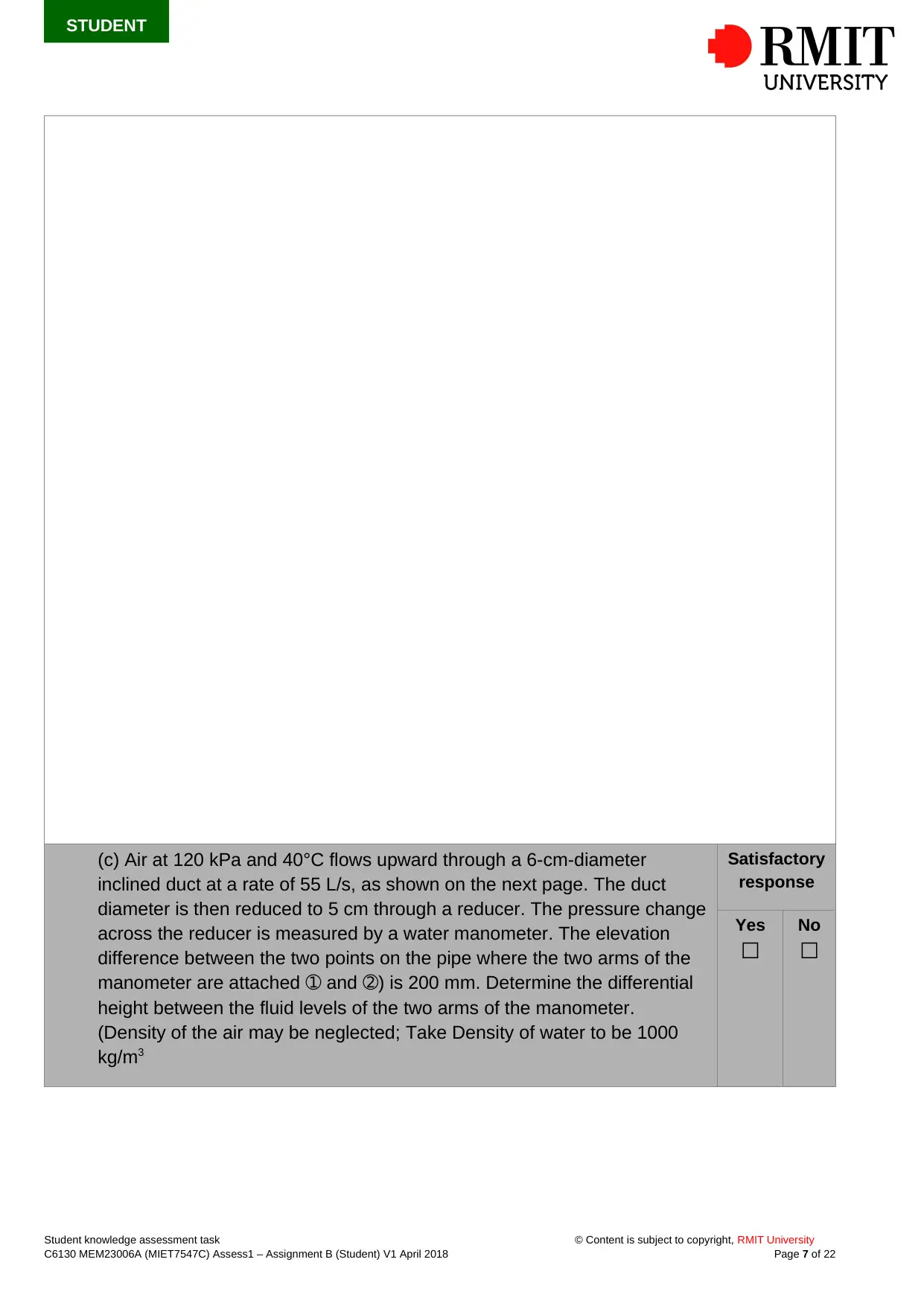
STUDENT
(c) Air at 120 kPa and 40°C flows upward through a 6-cm-diameter
inclined duct at a rate of 55 L/s, as shown on the next page. The duct
diameter is then reduced to 5 cm through a reducer. The pressure change
across the reducer is measured by a water manometer. The elevation
difference between the two points on the pipe where the two arms of the
manometer are attached ➀ and ➁) is 200 mm. Determine the differential
height between the fluid levels of the two arms of the manometer.
(Density of the air may be neglected; Take Density of water to be 1000
kg/m3
Satisfactory
response
Yes
☐
No
☐
Student knowledge assessment task © Content is subject to copyright, RMIT University
C6130 MEM23006A (MIET7547C) Assess1 – Assignment B (Student) V1 April 2018 Page 7 of 22
(c) Air at 120 kPa and 40°C flows upward through a 6-cm-diameter
inclined duct at a rate of 55 L/s, as shown on the next page. The duct
diameter is then reduced to 5 cm through a reducer. The pressure change
across the reducer is measured by a water manometer. The elevation
difference between the two points on the pipe where the two arms of the
manometer are attached ➀ and ➁) is 200 mm. Determine the differential
height between the fluid levels of the two arms of the manometer.
(Density of the air may be neglected; Take Density of water to be 1000
kg/m3
Satisfactory
response
Yes
☐
No
☐
Student knowledge assessment task © Content is subject to copyright, RMIT University
C6130 MEM23006A (MIET7547C) Assess1 – Assignment B (Student) V1 April 2018 Page 7 of 22
Paraphrase This Document
Need a fresh take? Get an instant paraphrase of this document with our AI Paraphraser
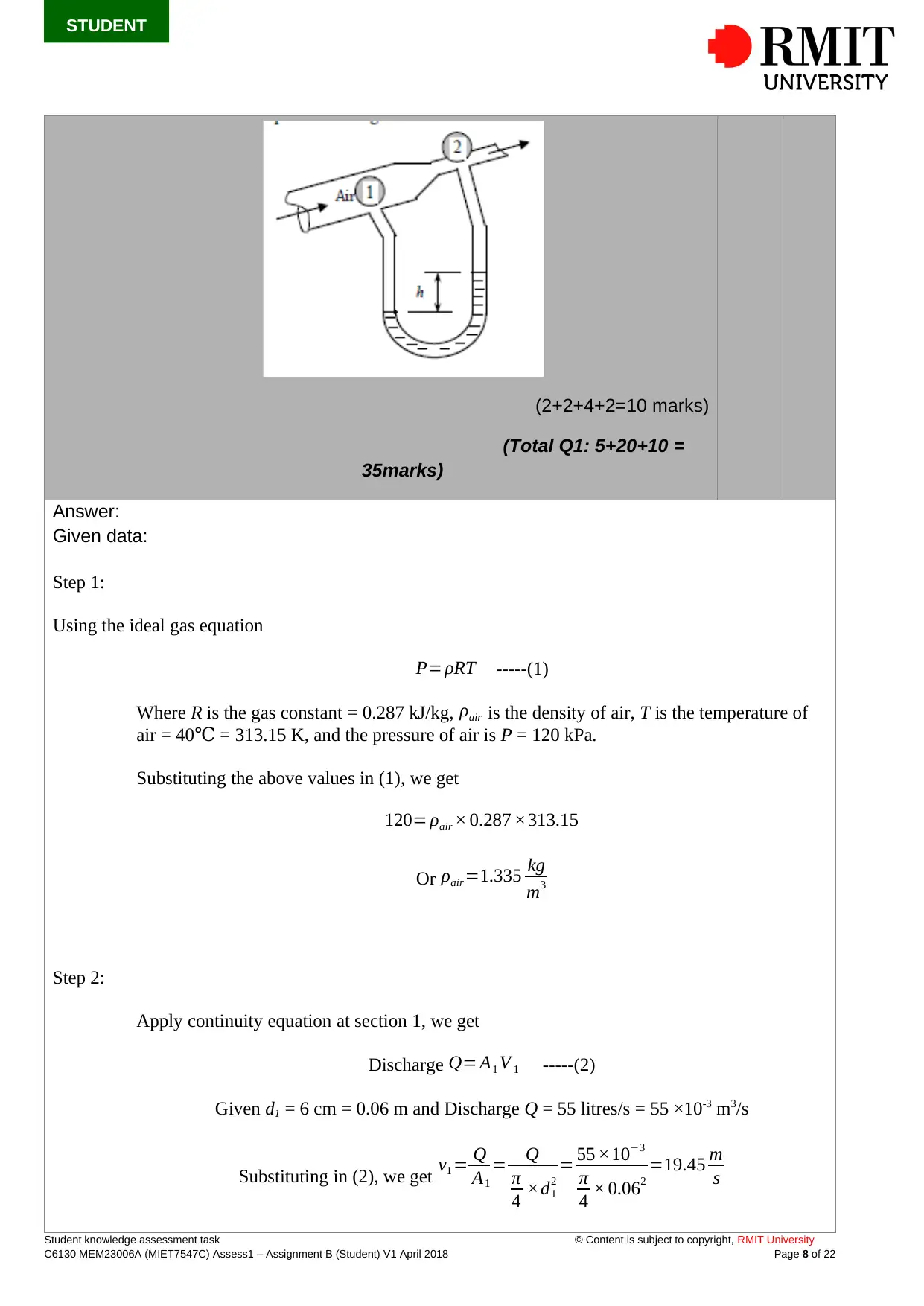
STUDENT
(2+2+4+2=10 marks)
(Total Q1: 5+20+10 =
35marks)
Answer:
Given data:
Step 1:
Using the ideal gas equation
P= ρRT -----(1)
Where R is the gas constant = 0.287 kJ/kg, ρair is the density of air, T is the temperature of
air = 40 = 313.15 K, and the pressure of air is℃ P = 120 kPa.
Substituting the above values in (1), we get
120= ρair × 0.287 ×313.15
Or ρair=1.335 kg
m3
Step 2:
Apply continuity equation at section 1, we get
Discharge Q= A1 V 1 -----(2)
Given d1 = 6 cm = 0.06 m and Discharge Q = 55 litres/s = 55 ×10-3 m3/s
Substituting in (2), we get v1 = Q
A1
= Q
π
4 ×d1
2
= 55 ×10−3
π
4 × 0.062
=19.45 m
s
Student knowledge assessment task © Content is subject to copyright, RMIT University
C6130 MEM23006A (MIET7547C) Assess1 – Assignment B (Student) V1 April 2018 Page 8 of 22
(2+2+4+2=10 marks)
(Total Q1: 5+20+10 =
35marks)
Answer:
Given data:
Step 1:
Using the ideal gas equation
P= ρRT -----(1)
Where R is the gas constant = 0.287 kJ/kg, ρair is the density of air, T is the temperature of
air = 40 = 313.15 K, and the pressure of air is℃ P = 120 kPa.
Substituting the above values in (1), we get
120= ρair × 0.287 ×313.15
Or ρair=1.335 kg
m3
Step 2:
Apply continuity equation at section 1, we get
Discharge Q= A1 V 1 -----(2)
Given d1 = 6 cm = 0.06 m and Discharge Q = 55 litres/s = 55 ×10-3 m3/s
Substituting in (2), we get v1 = Q
A1
= Q
π
4 ×d1
2
= 55 ×10−3
π
4 × 0.062
=19.45 m
s
Student knowledge assessment task © Content is subject to copyright, RMIT University
C6130 MEM23006A (MIET7547C) Assess1 – Assignment B (Student) V1 April 2018 Page 8 of 22
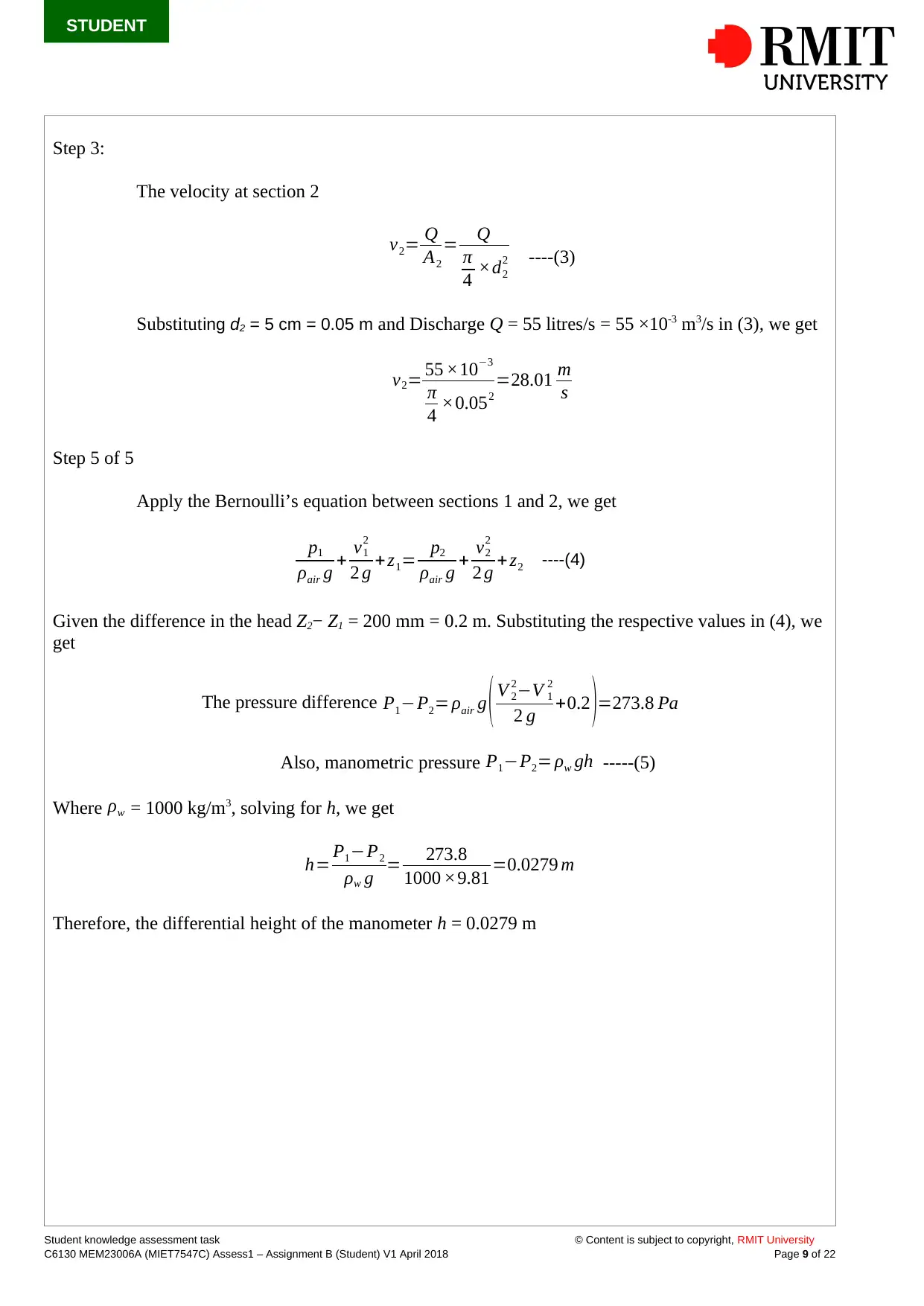
STUDENT
Step 3:
The velocity at section 2
v2= Q
A2
= Q
π
4 ×d2
2 ----(3)
Substituting d2 = 5 cm = 0.05 m and Discharge Q = 55 litres/s = 55 ×10-3 m3/s in (3), we get
v2= 55 ×10−3
π
4 ×0.052
=28.01 m
s
Step 5 of 5
Apply the Bernoulli’s equation between sections 1 and 2, we get
p1
ρair g + v1
2
2 g +z1= p2
ρair g + v2
2
2 g + z2 ----(4)
Given the difference in the head Z2− Z1 = 200 mm = 0.2 m. Substituting the respective values in (4), we
get
The pressure difference P1−P2= ρair g ( V 2
2−V 1
2
2 g +0.2 )=273.8 Pa
Also, manometric pressure P1−P2= ρw gh -----(5)
Where ρw = 1000 kg/m3, solving for h, we get
h= P1−P2
ρw g = 273.8
1000 ×9.81 =0.0279 m
Therefore, the differential height of the manometer h = 0.0279 m
Student knowledge assessment task © Content is subject to copyright, RMIT University
C6130 MEM23006A (MIET7547C) Assess1 – Assignment B (Student) V1 April 2018 Page 9 of 22
Step 3:
The velocity at section 2
v2= Q
A2
= Q
π
4 ×d2
2 ----(3)
Substituting d2 = 5 cm = 0.05 m and Discharge Q = 55 litres/s = 55 ×10-3 m3/s in (3), we get
v2= 55 ×10−3
π
4 ×0.052
=28.01 m
s
Step 5 of 5
Apply the Bernoulli’s equation between sections 1 and 2, we get
p1
ρair g + v1
2
2 g +z1= p2
ρair g + v2
2
2 g + z2 ----(4)
Given the difference in the head Z2− Z1 = 200 mm = 0.2 m. Substituting the respective values in (4), we
get
The pressure difference P1−P2= ρair g ( V 2
2−V 1
2
2 g +0.2 )=273.8 Pa
Also, manometric pressure P1−P2= ρw gh -----(5)
Where ρw = 1000 kg/m3, solving for h, we get
h= P1−P2
ρw g = 273.8
1000 ×9.81 =0.0279 m
Therefore, the differential height of the manometer h = 0.0279 m
Student knowledge assessment task © Content is subject to copyright, RMIT University
C6130 MEM23006A (MIET7547C) Assess1 – Assignment B (Student) V1 April 2018 Page 9 of 22
⊘ This is a preview!⊘
Do you want full access?
Subscribe today to unlock all pages.

Trusted by 1+ million students worldwide
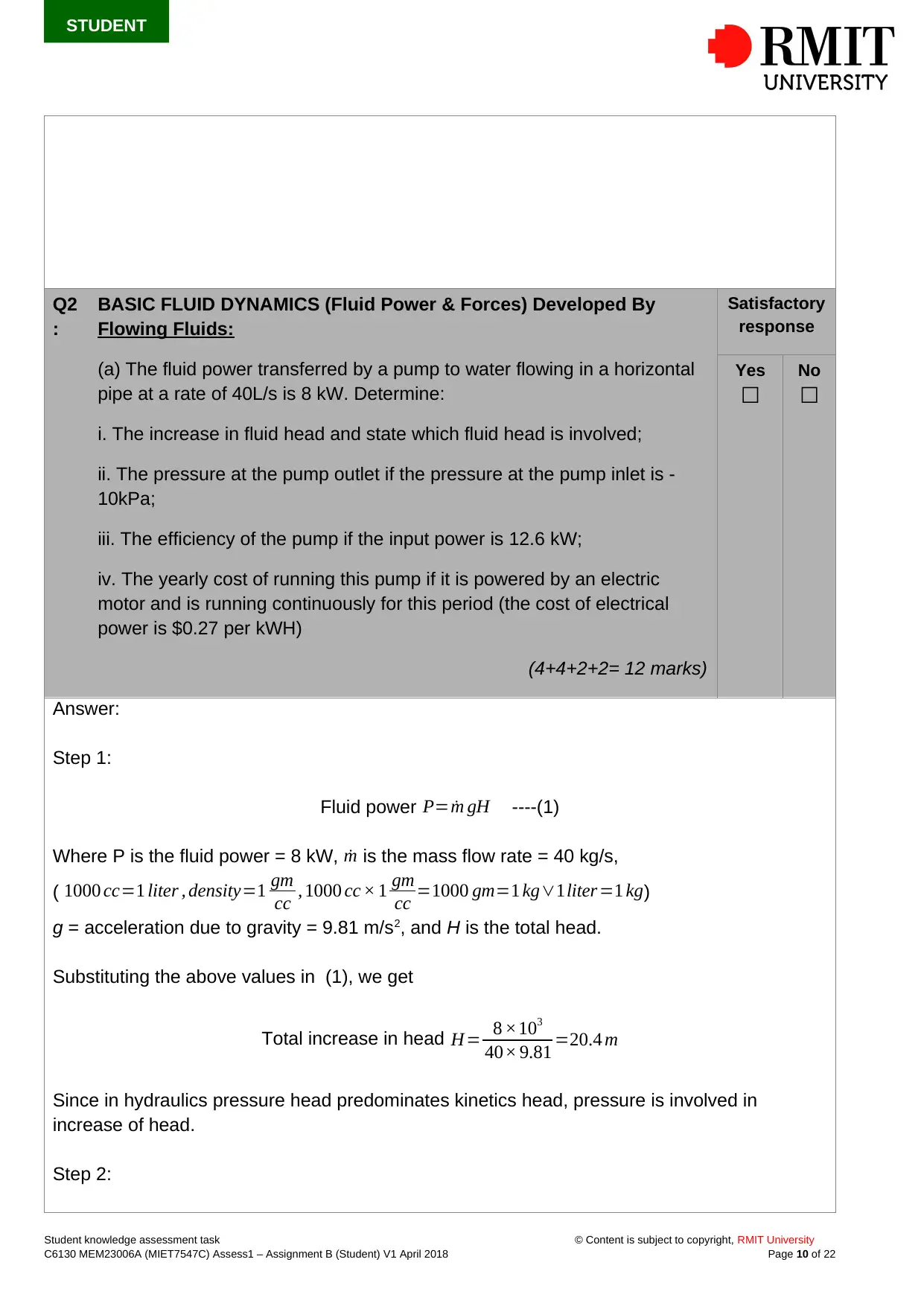
STUDENT
Q2
:
BASIC FLUID DYNAMICS (Fluid Power & Forces) Developed By
Flowing Fluids:
(a) The fluid power transferred by a pump to water flowing in a horizontal
pipe at a rate of 40L/s is 8 kW. Determine:
i. The increase in fluid head and state which fluid head is involved;
ii. The pressure at the pump outlet if the pressure at the pump inlet is -
10kPa;
iii. The efficiency of the pump if the input power is 12.6 kW;
iv. The yearly cost of running this pump if it is powered by an electric
motor and is running continuously for this period (the cost of electrical
power is $0.27 per kWH)
(4+4+2+2= 12 marks)
Satisfactory
response
Yes
☐
No
☐
Answer:
Step 1:
Fluid power P= ˙m gH ----(1)
Where P is the fluid power = 8 kW, ˙m is the mass flow rate = 40 kg/s,
( 1000 cc=1 liter , density=1 gm
cc , 1000 cc × 1 gm
cc =1000 gm=1 kg∨1liter=1 kg)
g = acceleration due to gravity = 9.81 m/s2, and H is the total head.
Substituting the above values in (1), we get
Total increase in head H= 8 ×103
40× 9.81 =20.4 m
Since in hydraulics pressure head predominates kinetics head, pressure is involved in
increase of head.
Step 2:
Student knowledge assessment task © Content is subject to copyright, RMIT University
C6130 MEM23006A (MIET7547C) Assess1 – Assignment B (Student) V1 April 2018 Page 10 of 22
Q2
:
BASIC FLUID DYNAMICS (Fluid Power & Forces) Developed By
Flowing Fluids:
(a) The fluid power transferred by a pump to water flowing in a horizontal
pipe at a rate of 40L/s is 8 kW. Determine:
i. The increase in fluid head and state which fluid head is involved;
ii. The pressure at the pump outlet if the pressure at the pump inlet is -
10kPa;
iii. The efficiency of the pump if the input power is 12.6 kW;
iv. The yearly cost of running this pump if it is powered by an electric
motor and is running continuously for this period (the cost of electrical
power is $0.27 per kWH)
(4+4+2+2= 12 marks)
Satisfactory
response
Yes
☐
No
☐
Answer:
Step 1:
Fluid power P= ˙m gH ----(1)
Where P is the fluid power = 8 kW, ˙m is the mass flow rate = 40 kg/s,
( 1000 cc=1 liter , density=1 gm
cc , 1000 cc × 1 gm
cc =1000 gm=1 kg∨1liter=1 kg)
g = acceleration due to gravity = 9.81 m/s2, and H is the total head.
Substituting the above values in (1), we get
Total increase in head H= 8 ×103
40× 9.81 =20.4 m
Since in hydraulics pressure head predominates kinetics head, pressure is involved in
increase of head.
Step 2:
Student knowledge assessment task © Content is subject to copyright, RMIT University
C6130 MEM23006A (MIET7547C) Assess1 – Assignment B (Student) V1 April 2018 Page 10 of 22
Paraphrase This Document
Need a fresh take? Get an instant paraphrase of this document with our AI Paraphraser
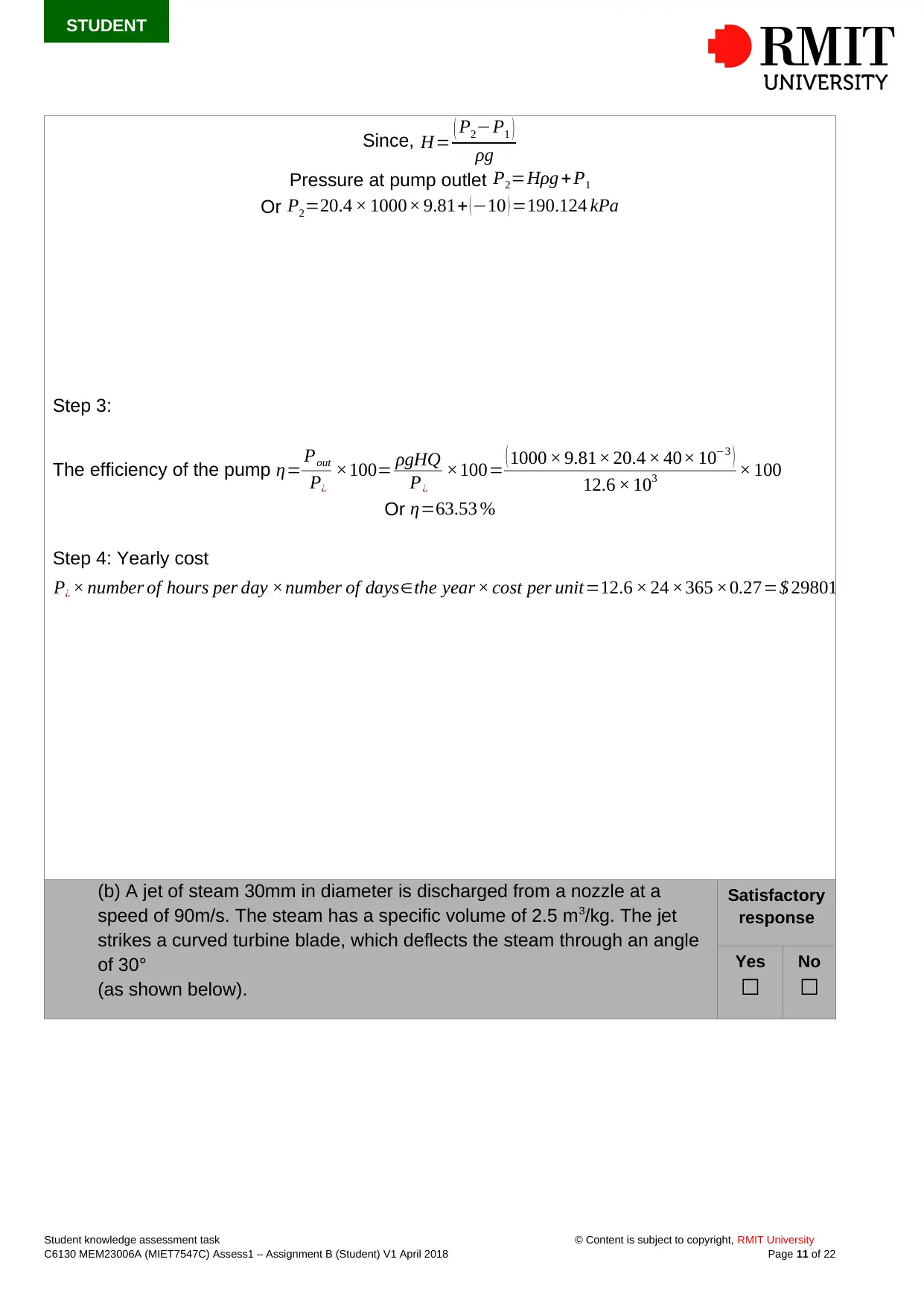
STUDENT
Since, H= ( P2−P1 )
ρg
Pressure at pump outlet P2=Hρg + P1
Or P2=20.4 × 1000× 9.81+ ( −10 ) =190.124 kPa
Step 3:
The efficiency of the pump η= Pout
P¿
×100= ρgHQ
P¿
×100= ( 1000 × 9.81× 20.4 × 40× 10−3 )
12.6 × 103 × 100
Or η=63.53 %
Step 4: Yearly cost
P¿ × number of hours per day ×number of days∈the year × cost per unit=12.6 × 24 ×365 ×0.27=$ 29801.52
(b) A jet of steam 30mm in diameter is discharged from a nozzle at a
speed of 90m/s. The steam has a specific volume of 2.5 m3/kg. The jet
strikes a curved turbine blade, which deflects the steam through an angle
of 30°
(as shown below).
Satisfactory
response
Yes
☐
No
☐
Student knowledge assessment task © Content is subject to copyright, RMIT University
C6130 MEM23006A (MIET7547C) Assess1 – Assignment B (Student) V1 April 2018 Page 11 of 22
Since, H= ( P2−P1 )
ρg
Pressure at pump outlet P2=Hρg + P1
Or P2=20.4 × 1000× 9.81+ ( −10 ) =190.124 kPa
Step 3:
The efficiency of the pump η= Pout
P¿
×100= ρgHQ
P¿
×100= ( 1000 × 9.81× 20.4 × 40× 10−3 )
12.6 × 103 × 100
Or η=63.53 %
Step 4: Yearly cost
P¿ × number of hours per day ×number of days∈the year × cost per unit=12.6 × 24 ×365 ×0.27=$ 29801.52
(b) A jet of steam 30mm in diameter is discharged from a nozzle at a
speed of 90m/s. The steam has a specific volume of 2.5 m3/kg. The jet
strikes a curved turbine blade, which deflects the steam through an angle
of 30°
(as shown below).
Satisfactory
response
Yes
☐
No
☐
Student knowledge assessment task © Content is subject to copyright, RMIT University
C6130 MEM23006A (MIET7547C) Assess1 – Assignment B (Student) V1 April 2018 Page 11 of 22
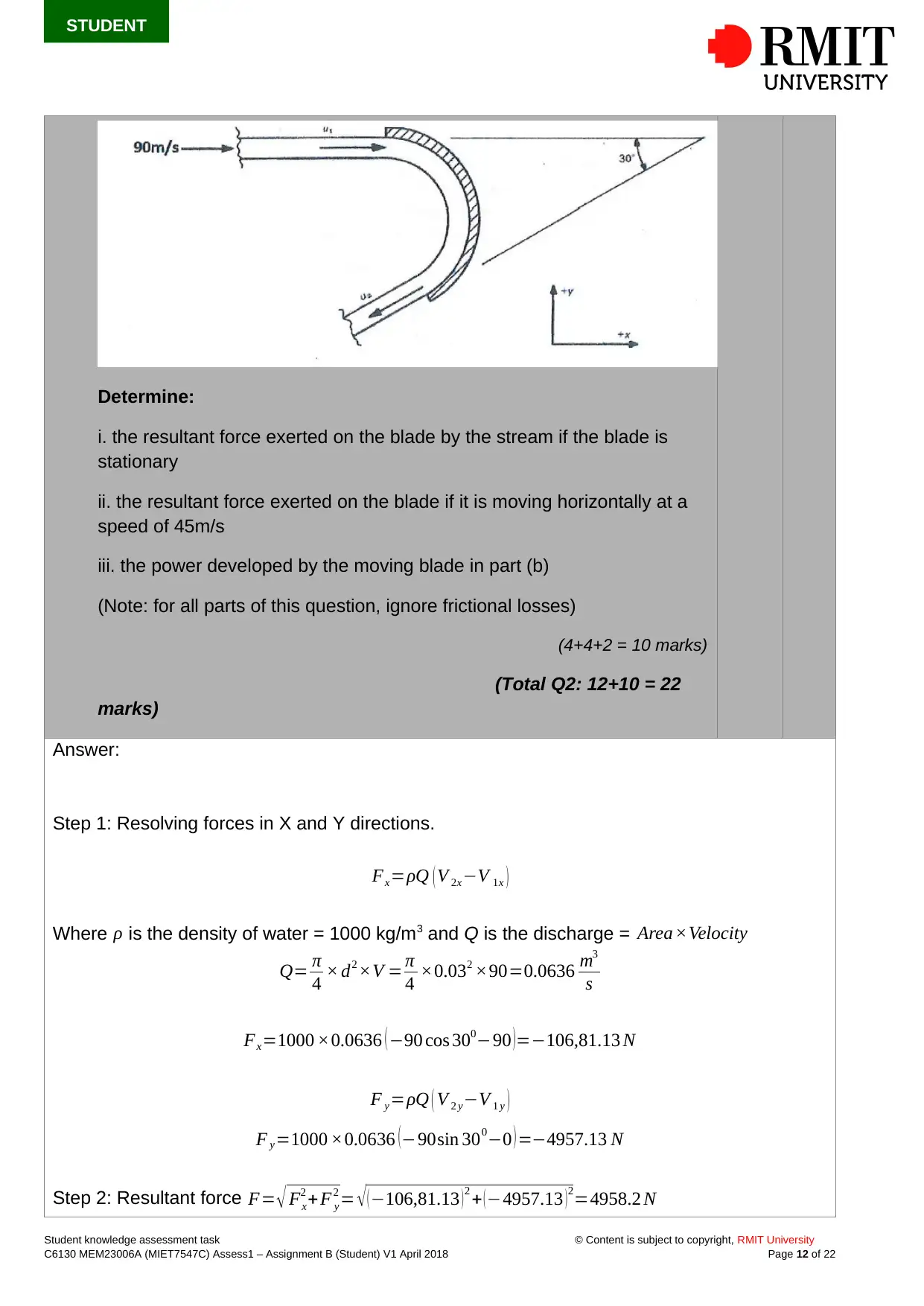
STUDENT
Determine:
i. the resultant force exerted on the blade by the stream if the blade is
stationary
ii. the resultant force exerted on the blade if it is moving horizontally at a
speed of 45m/s
iii. the power developed by the moving blade in part (b)
(Note: for all parts of this question, ignore frictional losses)
(4+4+2 = 10 marks)
(Total Q2: 12+10 = 22
marks)
Answer:
Step 1: Resolving forces in X and Y directions.
Fx=ρQ ( V 2x−V 1x )
Where ρ is the density of water = 1000 kg/m3 and Q is the discharge = Area×Velocity
Q= π
4 × d2 ×V = π
4 ×0.032 ×90=0.0636 m3
s
Fx=1000 ×0.0636 ( −90 cos 300−90 )=−106,81.13 N
F y=ρQ ( V 2 y−V 1 y )
F y=1000 ×0.0636 ( −90sin 300−0 ) =−4957.13 N
Step 2: Resultant force F= √ Fx
2 + F y
2 = √ ( −106,81.13 ) 2 + ( −4957.13 ) 2=4958.2 N
Student knowledge assessment task © Content is subject to copyright, RMIT University
C6130 MEM23006A (MIET7547C) Assess1 – Assignment B (Student) V1 April 2018 Page 12 of 22
Determine:
i. the resultant force exerted on the blade by the stream if the blade is
stationary
ii. the resultant force exerted on the blade if it is moving horizontally at a
speed of 45m/s
iii. the power developed by the moving blade in part (b)
(Note: for all parts of this question, ignore frictional losses)
(4+4+2 = 10 marks)
(Total Q2: 12+10 = 22
marks)
Answer:
Step 1: Resolving forces in X and Y directions.
Fx=ρQ ( V 2x−V 1x )
Where ρ is the density of water = 1000 kg/m3 and Q is the discharge = Area×Velocity
Q= π
4 × d2 ×V = π
4 ×0.032 ×90=0.0636 m3
s
Fx=1000 ×0.0636 ( −90 cos 300−90 )=−106,81.13 N
F y=ρQ ( V 2 y−V 1 y )
F y=1000 ×0.0636 ( −90sin 300−0 ) =−4957.13 N
Step 2: Resultant force F= √ Fx
2 + F y
2 = √ ( −106,81.13 ) 2 + ( −4957.13 ) 2=4958.2 N
Student knowledge assessment task © Content is subject to copyright, RMIT University
C6130 MEM23006A (MIET7547C) Assess1 – Assignment B (Student) V1 April 2018 Page 12 of 22
⊘ This is a preview!⊘
Do you want full access?
Subscribe today to unlock all pages.

Trusted by 1+ million students worldwide
1 out of 22
Related Documents
Your All-in-One AI-Powered Toolkit for Academic Success.
+13062052269
info@desklib.com
Available 24*7 on WhatsApp / Email
![[object Object]](/_next/static/media/star-bottom.7253800d.svg)
Unlock your academic potential
Copyright © 2020–2026 A2Z Services. All Rights Reserved. Developed and managed by ZUCOL.




